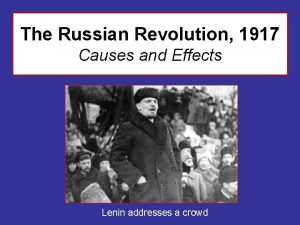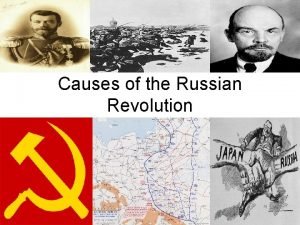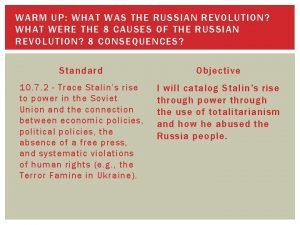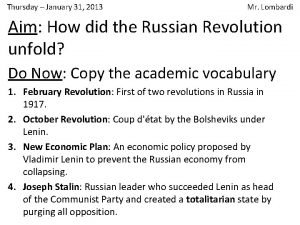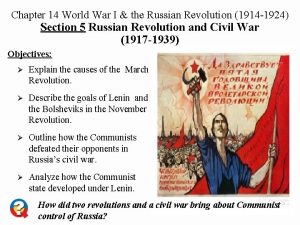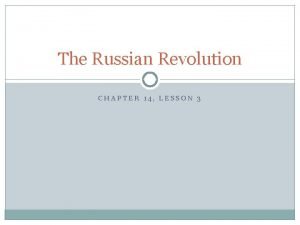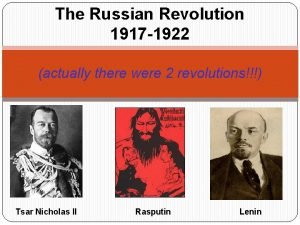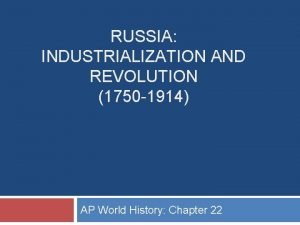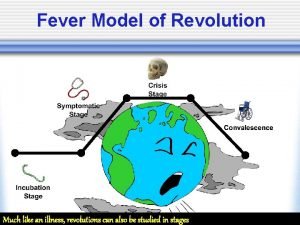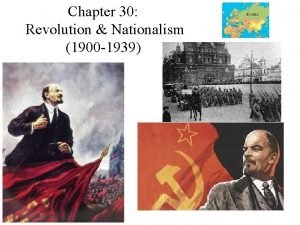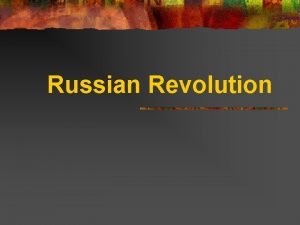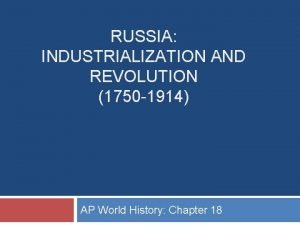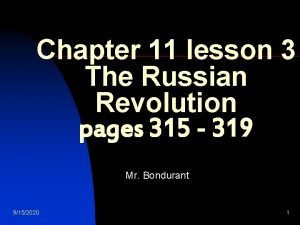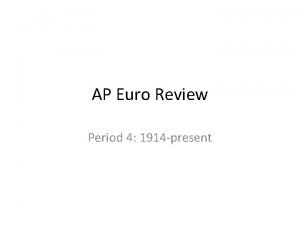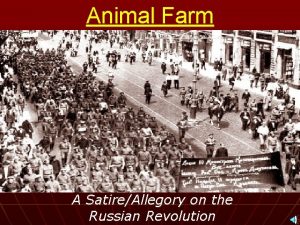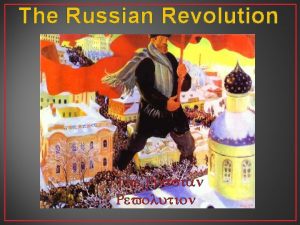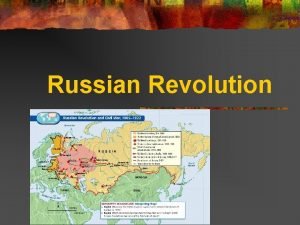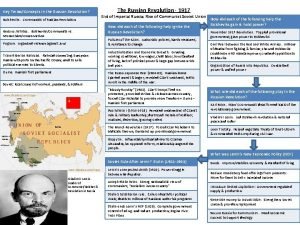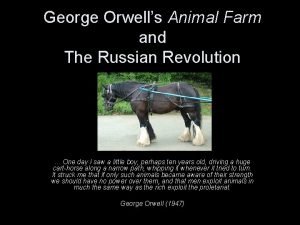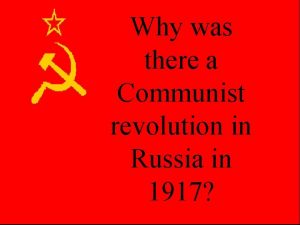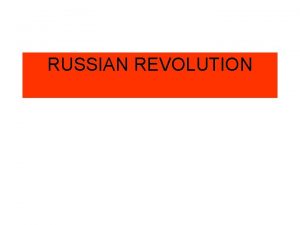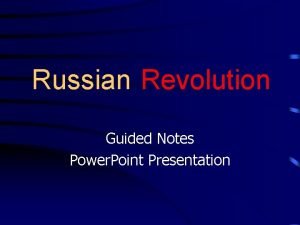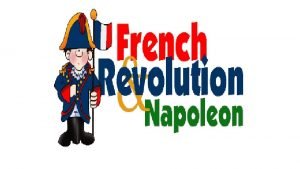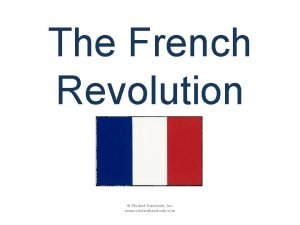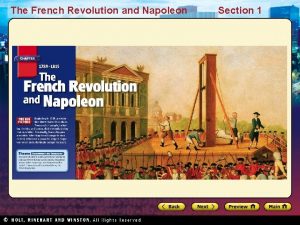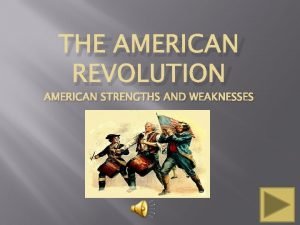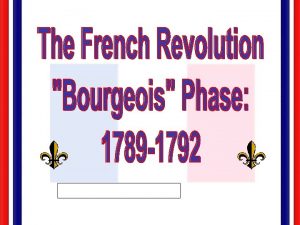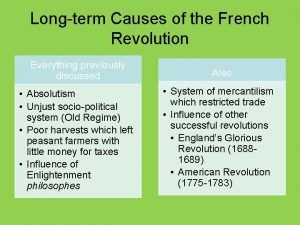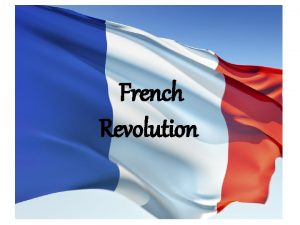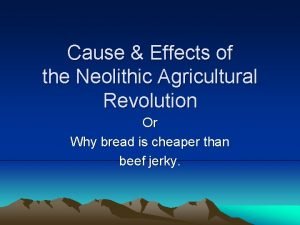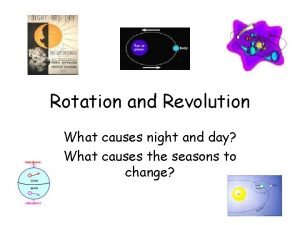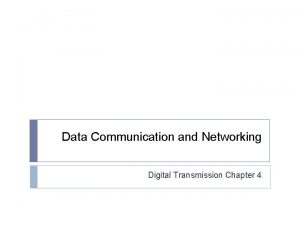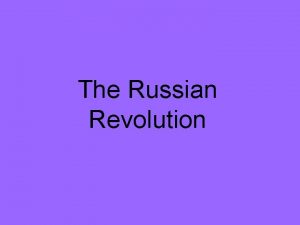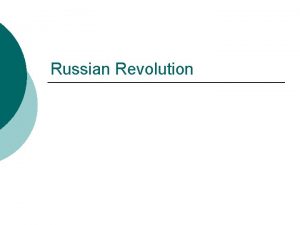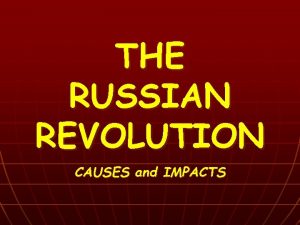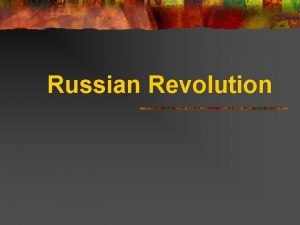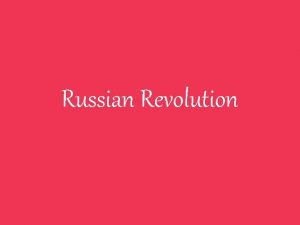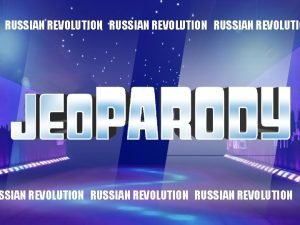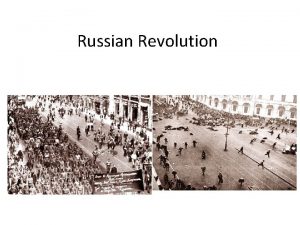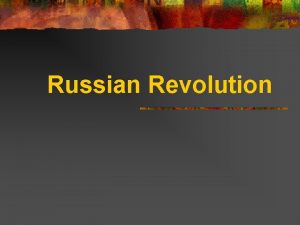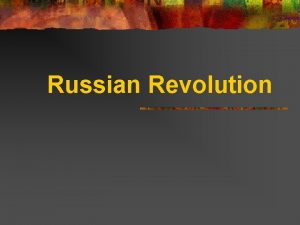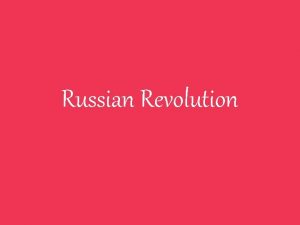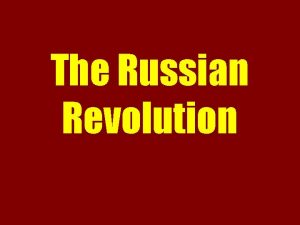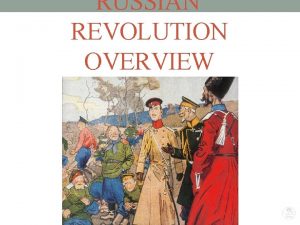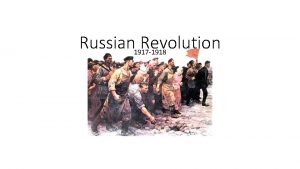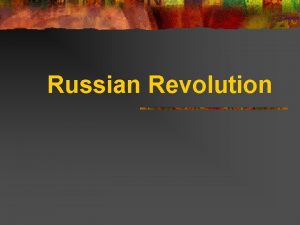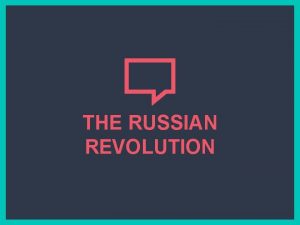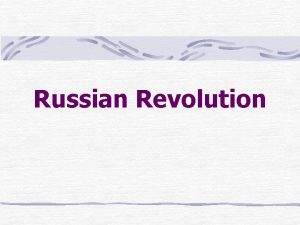Russian Revolution Element Determine the causes and results




































- Slides: 36

Russian Revolution • Element: Determine the causes and results of the Russian Revolution from the rise of the Bolsheviks under Lenin to Stalin’s first Five Year Plan. • Vocabulary: Russian Revolution, Bolsheviks, Lenin, Stalin, Five Year Plan

Czarist Russia • under Nicholas II • lagged behind the rest of Europe • technology was not as advanced • lacked modern industrialization • entered World War I and was not prepared for war • the nation was poor • many peasants were starving

Russian Society under the Czar • Czar Nicholas II – absolute power • all documents were censored • Russian was the only legal language in the empire • Secret Police sent violators to Siberia

Impact of World War I • exhausted more money and food away from Russia’s citizens to support the war effort • millions of Russians, both soldiers and civilians, suffered and died • the czar became more unpopular • people of all classes began calling for change in the Russian government

Industrialization leads to problems • Factory work consisted of terrible working conditions, child labor, low wages, and no unions • Revolutionary movements were starting

Stop and Think! • Why would the people of Russia want a new government? (What issues were going on in Russia at the time? ) • Turn and talk to your elbow partner. Make a list of problems in Russia. Be prepared to share your answers!

Karl Marx • Communism- a system in which all private property is owned by the community and shared by all. • He believed wealth should not be in the hands of a few. • The proletariats or working class should revolt and rule the country.

In Summary… • According to the Communist Manifesto, how should wealth be distributed? • Who’s idea was Communism? • Describe the meaning of the term “proletariat. ”

Uprisings • erupted in 1917 • among the lower working classes, strikes broke out • objected to involvement in WWI • Czar Nicholas II ordered troops to put down the uprisings

March Revolution • many soldiers switched sides and joined the rebellious crowds • Czar Nicholas II abdicated (step down) the throne on March 12

Provisional Government • Government in hands of Duma (Parliament) • Provisional(temporary) government takes over • led by Alexander Kerensky • Russia stays in World War I • Russian people continued to suffer

Rise of the Bolsheviks Vladimir Lenin: • Bolsheviks- Radical group of Marxists in Russia • Vladimir Lenin led this group • opposed Czarist regime • fled from Russia in the early 1900 s to avoid arrest

Out of Exile • Lenin returned in 1917 with support of Germany • the Bolsheviks overthrew the government

Bolshevik Revolution • Promised to redistribute land food to the poor, put power in the hands of the people, and pull Russia out of World War I • soon seized control of the Russian Government • sign peace treaty with Germany and leave World War I

In Summary… • Unrest over what issue forced the Czar to step down? • Name the Marxist group that wanted to lead a revolution in Russia. • Who was their leader?

Reds vs. Whites • three year civil war • between the Redssupporters of Bolsheviks, and the Whites-opponents of the Bolsheviks • after 14 million dead the Reds won

White Army support • allied countries (Great Britain, France, Japan, and the United States) also sent troops to Russia to support the anti-Communist forces • wanted to encourage Russia to re-enter the war

Results of the Russian Revolution • by 1921 Russia was firmly Communist • leaders never forgot the way Western nations sided with the anti-Communists • start of mistrust between the West and Communist East • transfer of power in Russia from aristocrats to leaders from the lower classes

Industrial Age of Russia • Russia ushered into the industrial age • people moved out of the country and into the cities • importance of education to catch up to the West • Bolsheviks determined to become selfsufficient from Western Europe

Establishment of the Soviet Union Challenges: • famine killed millions in Russia • nation’s industry collapsed • Lenin introduced New Economic Policy • allowed a limited amount of private ownership, while still maintaining state control over large industries and banks

USSR • The Union of Soviet Socialist Republics • established in 1922 by the Communist Party • improved agricultural conditions and new policies revived the economy • Lenin died in 1924

In Summary… • What were the two sides who fought in the Russian Civil War? • What was Russia renamed following their Civil War? • Why didn’t Communism work in practice?

New Leadership Leon Trotsky: • lead the army during the Bolshevik Revolution and the Russian Civil War • opposed to Lenin’s economic changes

Trotsky’s Vision for USSR • allow the state to seize all property and launch a massive program of industrialization • followers believed that the Soviet Union should do all in its power to encourage communist revolutions in other nations

New Leadership Joseph Stalin: • joined the Bolsheviks in 1903 • won Lenin’s favor after leading a bank robbery to get money for the party’s cause • became general secretary of the party under Lenin

Stalin’s Rise to Power • responsible for appointing people to important party posts • used his position to appoint people who later helped him seize and maintain his power • emerged as the nation’s dictator

Josef Stalin Quotations • Death is the solution to all problems. No man - no problem • I trust no one, not even myself. • Ideas are more powerful than guns. We would not let our enemies have guns, why should we let them have ideas. • Print is the sharpest and the strongest weapon of our party. • In the Soviet army it takes more courage to retreat than advance. • The death of one man is a tragedy. The death of millions is a statistic.

Stalin’s Economy • Soviet Union was behind Western Europe • Command Economy. Govt. makes all economic decisions • women were granted equal rights and forced to enter workforce

Stalin’s Five Year Plan • a plan for economic and military development • high quotas to meet in the production in industry (Steel, coal…) • Citizens often felt shortages on food, clothing, and housing.

Industry • sought to increase industrialization in the Soviet Union • established new, industrial cities • focused on the production of capital goods (goods used to make other goods, such as machines)

Impact of Industrialization • did little to care for the new industrial workforce • many Soviet workers lived in poverty as they worked long hours • communism offered no promise of more money or promotions for hard work • industrial production

Agriculture • transformed agriculture • instead of independent farms owned by peasants, Stalin collectivized agriculture • people worked stateowned land together instead of owning private land

Agricultural Response • many peasants resented this plan • protested by hoarding crops and killing livestock • the protest contributed to a famine that killed millions of Soviets during the early 1930 s

Stalin’s Response • Stalin’s policies did successfully increase industrial production • Stalin’s government appealed to national loyalty • used the fear of punishment as motivation for Soviet workers

• eliminated those perceived to be a threat • Bolshevik leaders and a number of military officers tried and convicted of crimes • many were executed • others shipped to Siberian prison camps • Trotsky fled to Mexico, only to be murdered with a pickax in 1940 • Stalin murdered millions of his own people before the end of his regime in 1953 The Purge

In Summary… • Describe the benefits and draw backs of the Five Year Plans. • Why were women given equal rights? • What is a command economy?
 Causes and effects of the russian revolution
Causes and effects of the russian revolution Causes and effects of the russian revolution
Causes and effects of the russian revolution Russian revolution effects
Russian revolution effects Causes of the russian revolution
Causes of the russian revolution Russian revolution vs french revolution
Russian revolution vs french revolution Chapter 27 world war 1 and the russian revolution
Chapter 27 world war 1 and the russian revolution Kzbho6asboc -site:youtube.com
Kzbho6asboc -site:youtube.com Russian
Russian Lesson 3 the russian revolution answer key
Lesson 3 the russian revolution answer key Czar in russian revolution
Czar in russian revolution How did vladimir lenin influence the russian revolution
How did vladimir lenin influence the russian revolution Russian industrialization ap world
Russian industrialization ap world Revolution fever model
Revolution fever model Chapter 30 revolution and nationalism worksheet answers
Chapter 30 revolution and nationalism worksheet answers Http://www.history.com/topics/russian-revolution
Http://www.history.com/topics/russian-revolution Russian revolution of 1905 definition ap world history
Russian revolution of 1905 definition ap world history Chapter 11 lesson 3
Chapter 11 lesson 3 Russian revolution 1917
Russian revolution 1917 Animal farm summary
Animal farm summary In the view of this cartoonist russia under
In the view of this cartoonist russia under The russian revolution
The russian revolution Russian revolution
Russian revolution Animal farm
Animal farm Introduction of russian revolution
Introduction of russian revolution Russian revolution
Russian revolution Russian revolution guided notes
Russian revolution guided notes Causes and effects of french revolution
Causes and effects of french revolution The effects of the french revolution
The effects of the french revolution French revolution
French revolution Causes and effects of american revolution
Causes and effects of american revolution French revolution causes and effects
French revolution causes and effects French revolution causes and effects
French revolution causes and effects American revolution causes and effects
American revolution causes and effects What was the social cause of french revolution
What was the social cause of french revolution Neolithic revolution causes and effects
Neolithic revolution causes and effects Revolution rotation difference
Revolution rotation difference Distinguish between a signal element and a data element.
Distinguish between a signal element and a data element.
